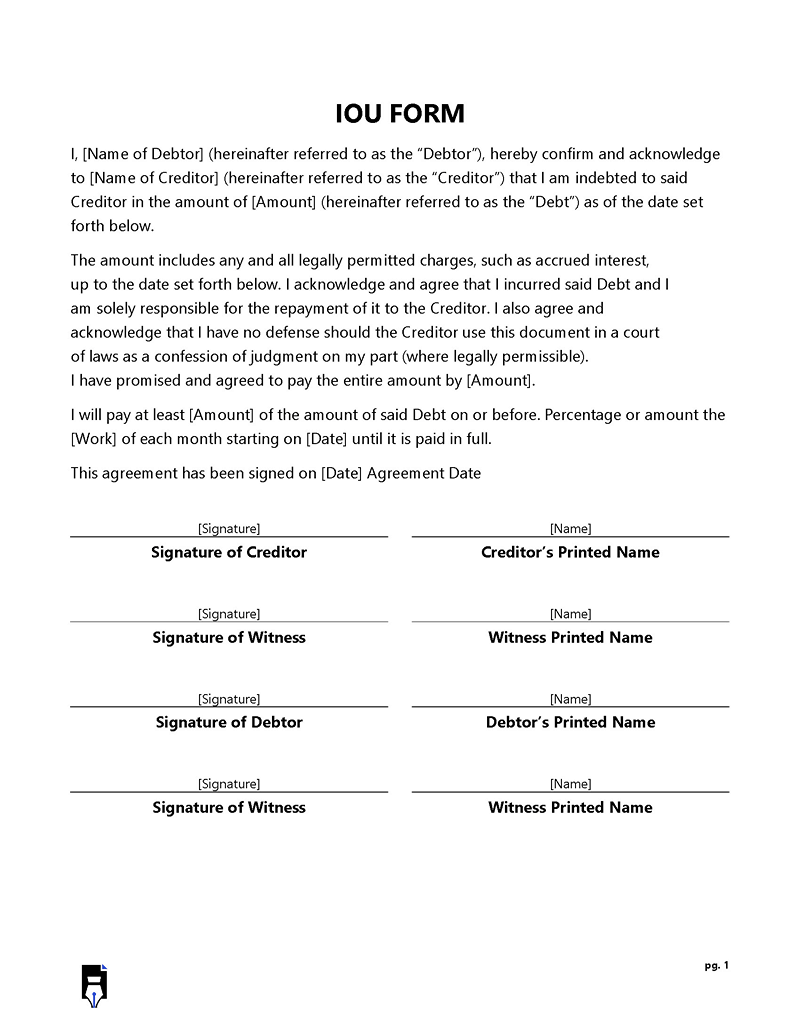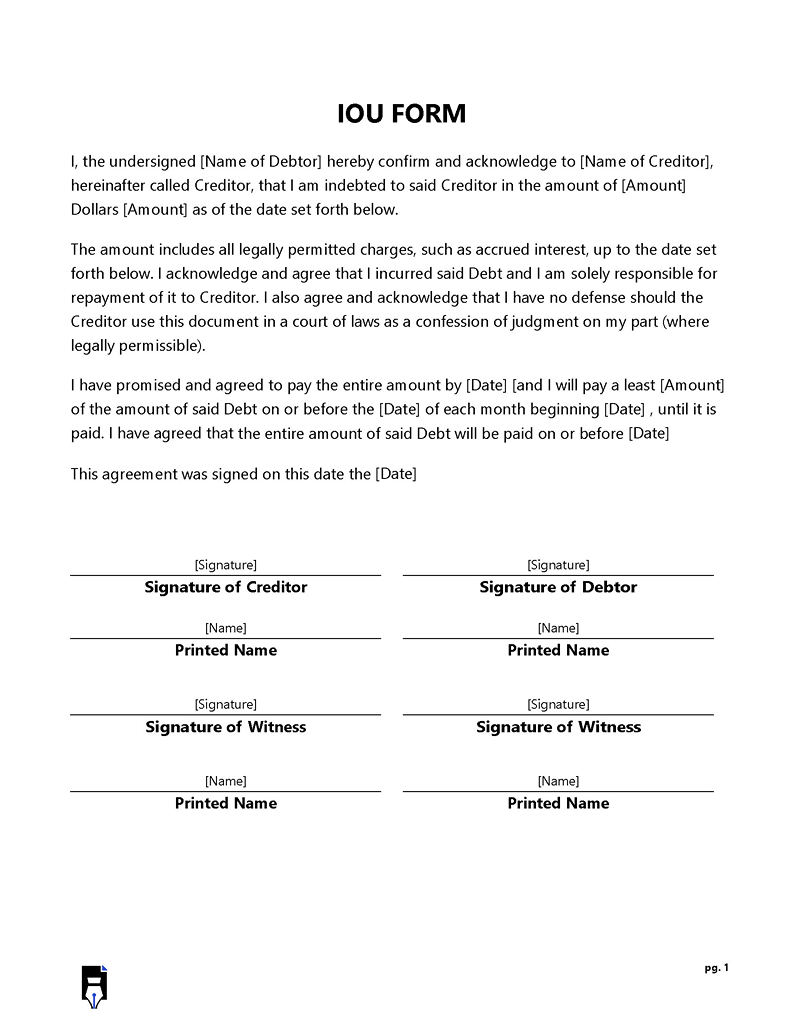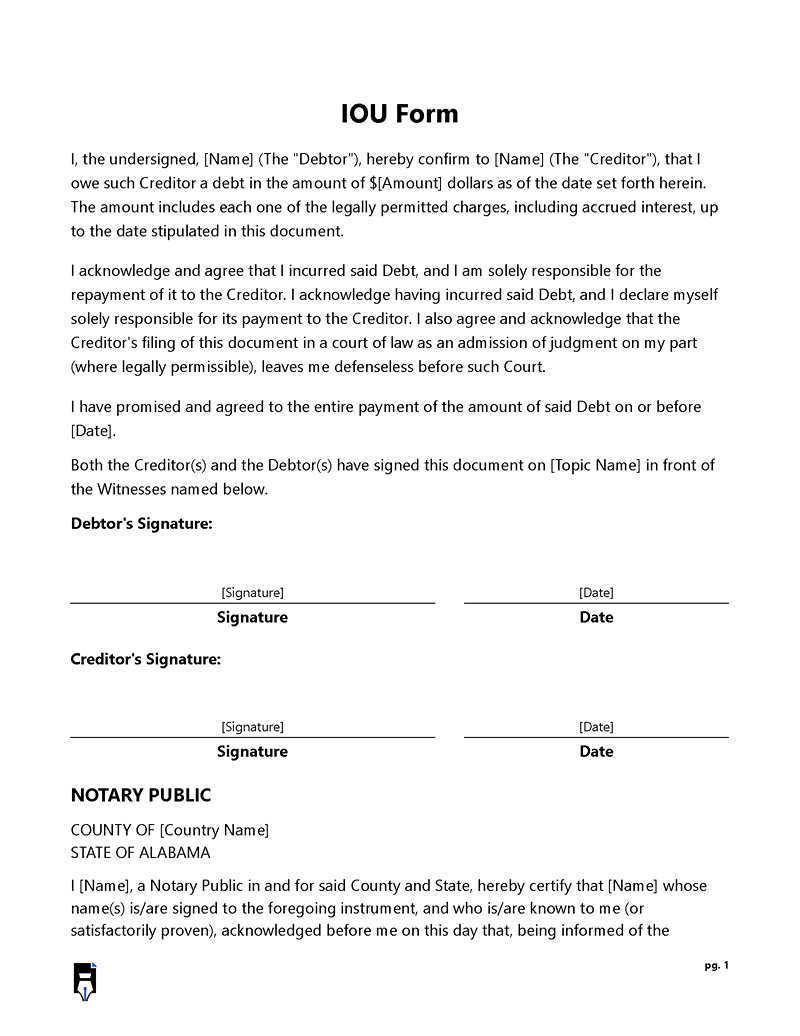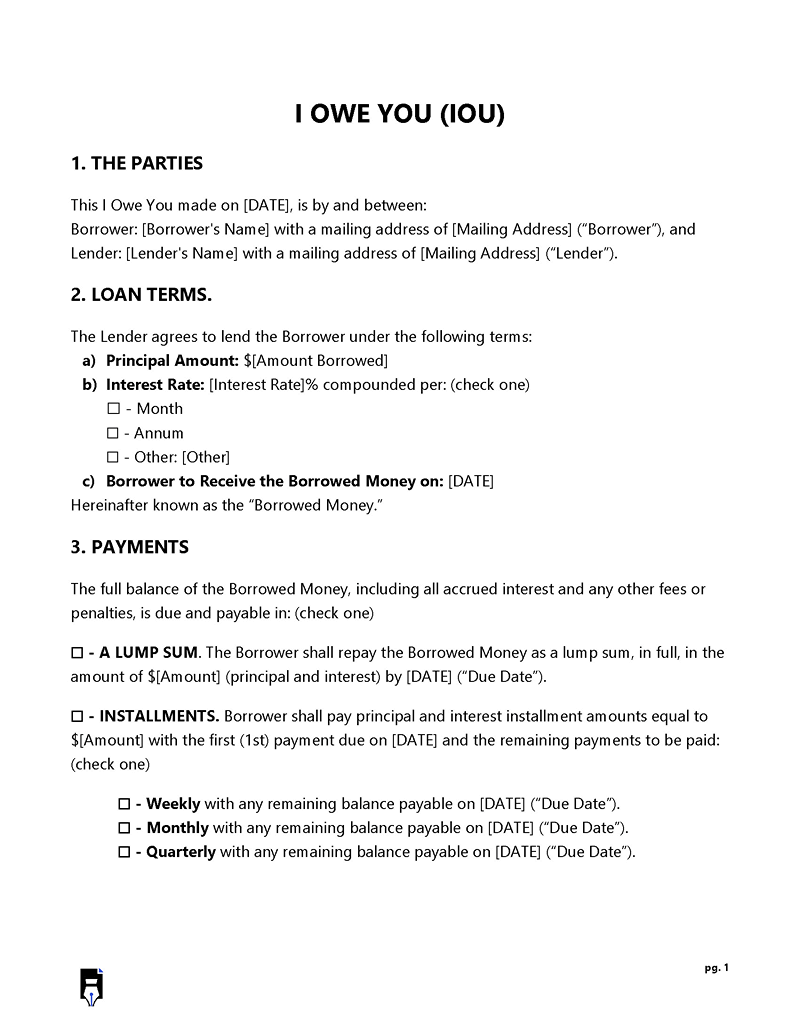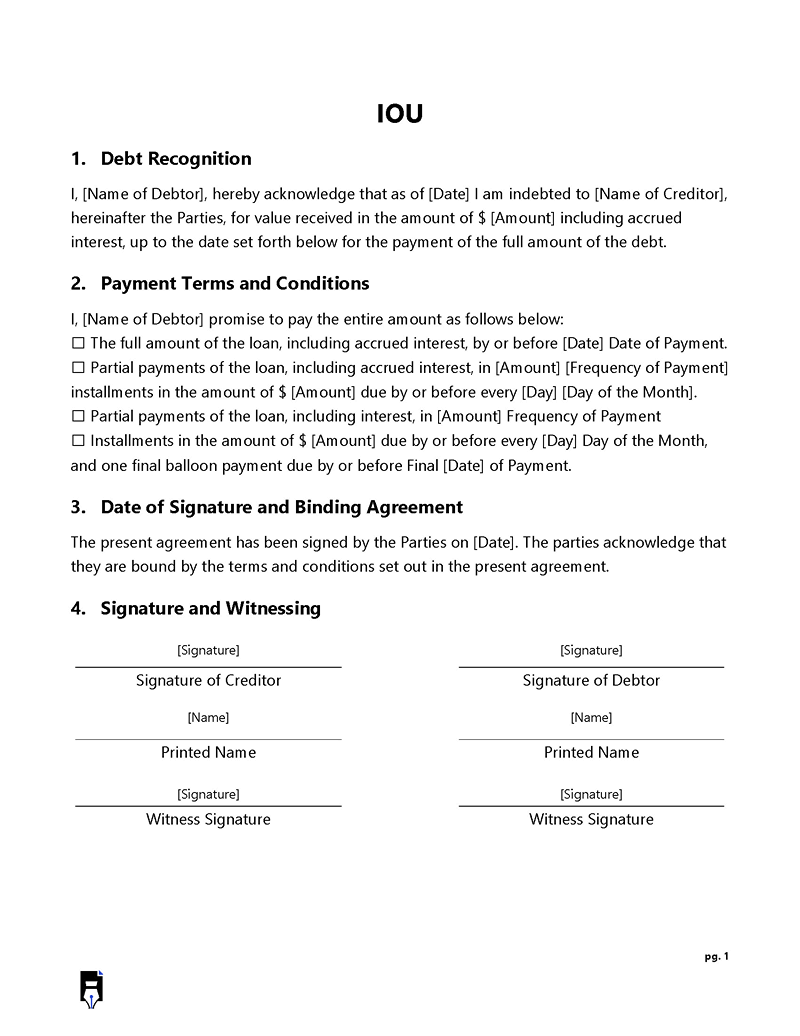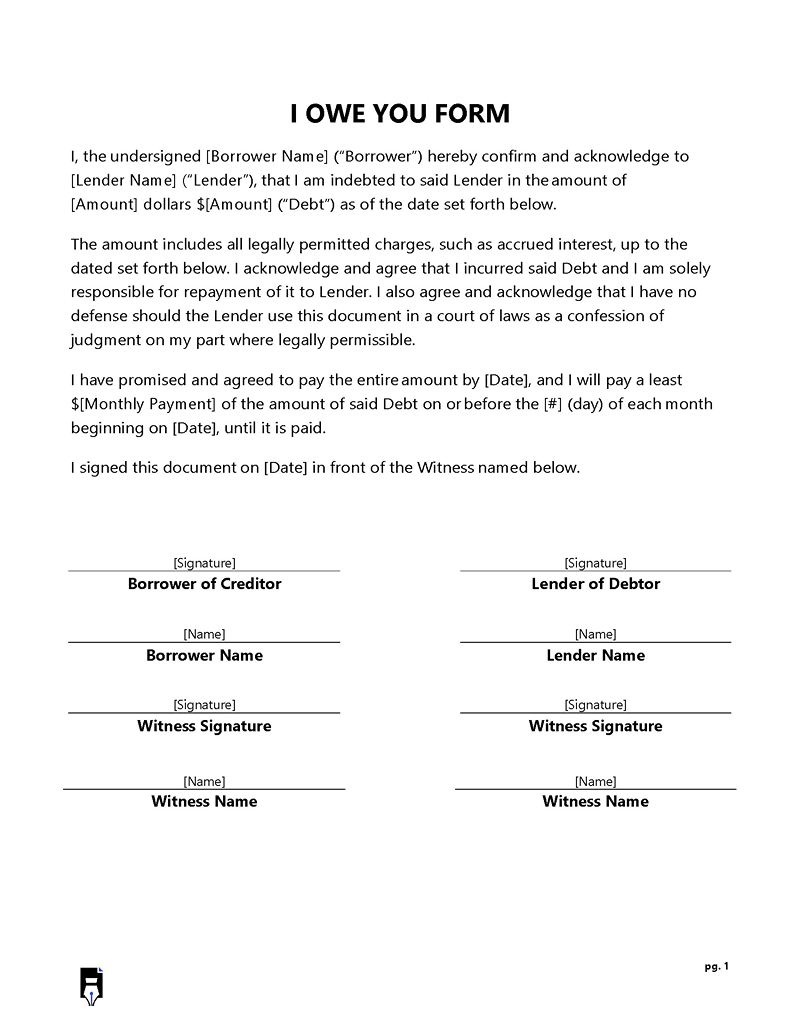Maintaining proper and accurate records is essential when documenting agreements between lenders and borrowers. They can be even more critical when lending money to family members, friends, and close associates. An IOU form can be a useful tool in these situations, not only providing a clear record of the debt but also helping to establish a timeline for repayment. It is considered a formal acknowledgment and promise by the borrower to repay the loan. It provides a sense of security or guarantees to the lender that, should the borrower fail to pay the loan, it can be used as a debt acknowledgment and proof of the loan amount in a legal proceeding.
This article discusses what an IOU document is and the essential elements of an IOU form. It also provides free templates that you can use to easily create one.
Did you know? 7% of people who lend money to their relatives and friends lose their relationships due to unpaid loans (National Foundation for Credit Counseling report).
IOU Form Templates
What is an IOU document?
An IOU, derived from “I Owe You,” is a written acknowledgment and promise by the borrower to repay an existing loan.
It is considered an informal loan agreement and illustrates the debtor’s commitment to repay a loan. The form entails the parties’ details, date, loan amount, payment plan, loan terms, and signatures. It must be signed to authenticate its stipulations. The form may be consulted to settle disputes should disagreements ensue in the future regarding what was agreed upon.
Other names used to refer to the document include:
- Debt Acknowledgement Form
- “I Owe You” Form
- Promise to pay agreement
Statistical insights: A survey by Credit Karma found that 38% of people in the U.S. have borrowed money from people they know. Also, according to Finder, 68% of people reported having lent money to relatives or friends, and 52% had borrowed loans from family members or friends.
IOU Vs. Promissory Note Vs. Loan Agreement
Lenders can use IOUs, promissory notes, and loan agreements to lend money to individuals and businesses. While these documents perform more or less the same function, which is to document the loan, they differ in more than one way.
The differences between the documents are as follows:
Purpose
IOUs are considered informal contracts and are only acceptable between people you know and trust, like family and friends. They are also suited for small personal loans. Contrarily, promissory notes and loan agreements are formal and are used for business loans that may involve significant amounts.
Specificity
Promissory notes and loan agreements are more detailed and include terms of payment such as interest rates, collateral, late fees, deadlines, etc. However, IOUs are simple and less detailed documents with basic information such as the loan amount and repayment plan.
Transferability
Lenders can transfer promissory notes to third parties but cannot transfer IOUs and loan agreements.
Legal enforceability
IOUs are generally not legally binding and lack enforceability in a court of law. On the other hand, promissory notes and loan agreements are legally enforceable contracts that can be used as evidence of the debt and to pursue legal remedies in the event of default.
Repayment terms
IOUs have more flexible repayment terms than promissory notes and loan agreements, as they may not require interest. However, promissory notes and loan agreements have more detailed and defined terms and conditions, such as interest rates, governing laws, fixed repayment schedules, etc. Additionally, loan agreements are highly detailed documents and may require collateral and default clauses to protect the lender from the risk of losing large sums of money.
What are Formal IOUs?
IOUs can be formal financial records, depending on their application. For example, IOUs in the bond market are deemed formal. Companies and governments issue these bonds to raise money from investors. Once issued, the bond issuer (borrower) is expected to repay the loan within a specified period and at an agreed-upon interest rate.
Is an IOU Agreement a Legal Document?
The form can be presented in court as legal evidence or a written acknowledgment of the existence of a debt. However, it is typically not considered to be legally binding, and thus its enforceability is limited. Nonetheless, this is subject to debate and interpretation and may vary from case to case. However, the more detailed the IOU, the more enforceable it may be. A form with very few details may be hard to enforce as it may not clarify the rights and obligations of the involved parties.
Basic Elements of an IOU Form
The lender can decide what information they require to be included in an IOU form. This means the form may vary from one situation to the next. However, there are some basic elements that must be there, which are discussed below:
Date
The form must record when the loan was given, including the date. The date must show the day, month, and year accurately.
Parties’ details
Two parties are involved in the transaction – the lender and the borrower. The document must indicate the respective parties’ names, addresses, phone numbers, and email addresses to make it easy for them to contact each other. It must also specify which party is the lender and which is the borrower.
Loan amount
It is important to specify how much money was loaned to the borrower to avoid any confusion or misunderstandings. The loan amount, typically referred to as the “principal”, should be written in figures and words and must include the appropriate currency, e.g., dollars ($).
Terms of repayment
The payment plan or schedule the borrower will follow to repay the loan must then be documented. This arrangement will depend on the approach chosen by both parties. There are several options for repayment.
These include:
- Total amount due on a specific date: This option requires the borrower to settle the debt in full at a predetermined date. The lender often determines the date.
- Installment payment: The loan can also be paid via installments or partial debt payments. The borrower is expected to pay the installments over a specified period of time.
- Installment plan with a balloon payment: This option allows the borrower to pay installments over a specified period and a balloon payment on the final due date. A balloon payment refers to a large, lump sum payment that is due at the end of a loan term.
- Due on demand: Lenders can also decide to use an option where the loan will be due upon request. This implies there is no specified due date.
Did you know? LendingTree reports that 37% of borrowers who get loans from friends and family find it challenging to pay them back, and 12% frequently default.
Interest rate (optional)
If interest is charged on the loan, it must be specified in the agreement. The document must state the interest rate and whether it will be calculated monthly, quarterly, or annually. However, this is optional in such transactions, as the loan amount may be too trivial to charge interest.
Important Note: Always consult local and state laws and regulations when charging interest on the loan. Such laws often dictate the maximum interest rates lenders can charge borrowers.
Cosigner or guarantor (optional)
In some cases, lenders may request that the borrower have a guarantor or cosigner as a guarantee that the money will be repaid. A cosigner assumes the debt obligation should the borrower default on the loan. The document should have a statement clarifying this provision and must indicate the guarantor’s details.
Other terms and conditions
Sometimes lenders may want to add additional terms and conditions to the arrangement. They can do so by defining them on the form. Examples of such additional elements include amendment and severability clauses. An amendment clause ensures that the IOU cannot be modified without the approval of both parties. A severability clause ensures that the IOU remains enforceable even after a section or clause of the document is determined to be invalid.
Governing law
The document must also specify which state’s laws are to be followed when enforcing the document. Ideally, this will be the resident state of the lender. This is an important element of the document, as it helps ensure that both parties are clear on the legal framework that governs the agreement.
Signatures
Signatures attest that the borrower and the lender agree to the content and stipulations of the form. The document must include the names of the parties next to their signatures. If a guarantor is named in the document, they must also sign it.
Note: An IOU can be typed or handwritten. Both are legally recognized in court as evidence of the existing debt. Additionally, it is advised to use a template to ensure that all the basic elements are present in the document. Templates are fillable and contain placeholders for all the relevant details, thus saving the time and effort needed to create a legally valid IOU. Such templates are available online for free.
Does an IOU Need to Be Notarized?
The decision of whether or not to notarize an IOU (I Owe You) document depends on several factors, including the jurisdiction you are in and the specific circumstances of the debt. Notarization is the process of having a notary public witness the signing of a document and attests to its authenticity.
While notarization is not always a legal requirement for an IOU, it can add an extra layer of validity and credibility to the document. Notarization assures that the signatures on the IOU are genuine and that all parties involved in the agreement have been identified. It can also help prevent any disputes or claims of forgery in the future.
Key Takeaways
- IOUs are written acknowledgments of the existence of debts between two parties.
- Although an IOU has limited legal enforceability, it is a more formal arrangement than a verbal one.
- It is advisable to use the document only for small loans between family members or friends due to its lack of legal protection and the high risk of loss of the money involved should the borrower default.
- Lenders can incorporate any specific terms and conditions in the agreement that are necessary to protect themselves from losing their money.
- Lenders should consider using templates to create IOUs to ensure the relevant information is documented.
- For loans of high value, it is advisable to use promissory notes or loan agreements depending on the legal requirements.
